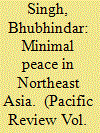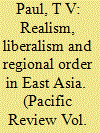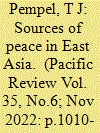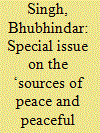|
|
|
Sort Order |
|
|
|
Items / Page
|
|
|
|
|
|
|
| Srl | Item |
| 1 |
ID:
187400


|
|
|
|
|
| Summary/Abstract |
Challenging a popular view that China’s rise will lead the United States and China to fall into the ‘Thucydides trap’—a possible hegemonic war between the two—this paper proposes an ‘institutional peace’ argument, suggesting that the ongoing international order transition will be different from previous order transitions in history. Instead of using military means to change the international order, China and the United States have relied on various institutional balancing strategies to compete with one another for an advantageous position in the future international order. The discussion on the institutional competition between China and the US around the AIIB and the ARF-related multilateral security architecture supports the ‘institutional peace’ argument: institutional competition in the form of institutional balancing strengthens the dynamics and utility of international institutions, encourages states to offer new public goods, and could lead to a more peaceful order transition in the international system. However, this institutional peace argument is constrained by two caveats: the continued validity of the MAD nuclear deterrence and a limited degree of ideological antagonism between the US and China.
|
|
|
|
|
|
|
|
|
|
|
|
|
|
|
|
| 2 |
ID:
187399


|
|
|
|
|
| Summary/Abstract |
Southeast Asia has gone through a remarkable transformation in recent decades and seen peaceful change since the end of the Cold War era despite great power interference and rivalry and ongoing territorial disputes including the South China Sea conflict. The region has transformed its image from the so-called Balkans of the East in the 1960s and 1970s to an economically competitive and peaceful region today. Despite these accomplishments, the record of the Association of Southeast Asian Nations (ASEAN) in maintaining regional peace and security has also been seriously challenged, particularly at the domestic and transnational level. The paper argues that the Southeast Asian experience of peaceful change calls for a different framework of analysis that goes beyond the traditional International Relations theories which do not provide a compelling answer to whether regional peace has prevailed. It reviews ASEAN’s approaches to managing peace and security in Southeast Asia and brings close attention to domestic and international dynamics. The paper claims that the Southeast Asian states’ approach to positive peace, reflected in the notion of comprehensive security and the building of national and regional resilience, is instructive in understanding peaceful transformations in the region.
|
|
|
|
|
|
|
|
|
|
|
|
|
|
|
|
| 3 |
ID:
187401


|
|
|
|
|
| Summary/Abstract |
This paper argues that amid intensifying Sino-U.S. rivalry, middle powers in East Asia have contributed towards regional peaceful change through the exercise of good regional citizenship, a concept which draws on and modifies from the more commonly known good international citizenship which is closely associated with middle powers. Specifically, good regional citizenship involves proactively strengthening inclusive multilateralism, enhancing the rules-based order, and contributing to bridging efforts in East Asia. The paper examines the good regional citizenship of two middle powers, namely Australia and Indonesia. It finds that while both countries have exercised good regional citizenship, their specific strategies or the outcomes of their initiatives on regional dynamics have varied as a result of their relations with the respective major powers and their general foreign policy approaches. Australia’s good regional citizenship has supported the preservation of U.S. leadership in East Asia vis-à-vis the rise of other regional powers, while Indonesia’s good regional citizenship has helped to narrow the gaps among regional actors through mechanisms led by the Association of Southeast Asian Nations (ASEAN).
|
|
|
|
|
|
|
|
|
|
|
|
|
|
|
|
| 4 |
ID:
187398


|
|
|
|
|
| Summary/Abstract |
Northeast Asia is usually associated with conflict and war. Challenging this prevailing view, this article shows that the sub-region has achieved minimal peace since its peaceful transition from the Cold War to the post-Cold War period. The questions posed are: (a) what factors are responsible for Northeast Asia’s minimal peace?; and (b) how will these factors respond to the worsening US-China competition since 2010? This article’s argument is two-fold. First, Northeast Asia’s minimal peace is explained by three realist-liberal factors: America’s hegemony; strong economic interdependence among the Northeast Asian states; and a stable institutional structure in East Asia, including Northeast Asia. These factors kept a stable balance of power, ensured development and prosperity, and mitigated the political and strategic tensions between the states. Second, Northeast Asia’s minimal peace would be durable to counter the negative effects of the Sino-US competition in the coming decades. While the economic interdependence and institutional building factors have shown resilience, the US hegemony faces a robust challenge from China. Nevertheless, the US hegemony is durable because of America’s enduring relative strategic and economic advantages over China, the expanded role of America’s regional allies to preserve US preponderance and China’s problems in building an alternative regional order.
|
|
|
|
|
|
|
|
|
|
|
|
|
|
|
|
| 5 |
ID:
187397


|
|
|
|
|
| Summary/Abstract |
East Asia offers a fertile ground for applying dominant theoretical perspectives in International Relations and understanding their relevance and limitations. As this region has seen much conflict and cooperation historically and is re-emerging as a key theater of great power competition in the 21st century even when states maintain high levels of economic interactions, our understanding of the regional order will be enhanced by the theoretical tools available in the larger mainstream IR perspectives. The existence of a peculiar regional order of no war, yet a number of simmering disputes (along with high levels of economic interdependence) can be characterized as cold peace which deserves an explanation. The paper applies two variants of realism—balance of power and hegemonic stability – and the key arguments in liberalism to analyze the cold peace in Northeast Asia and normal peace in Southeast Asia from a historical perspective. It finds both grand theoretical approaches have partial applications for understanding the East Asian order. A hybrid approach is more valuable to better explain regional order during diverse time periods and different sub-regions of East Asia. Although the presence of both hegemony and balance of power can prevent major wars for a period, they do not help resolve the pre-existing disputes. Deepened economic interdependence mitigates some spiraling tendencies as states fearful of losing too much economically do not escalate crises beyond a point.
|
|
|
|
|
|
|
|
|
|
|
|
|
|
|
|
| 6 |
ID:
187396


|
|
|
|
|
| Summary/Abstract |
For forty years, the East Asian regional order has delivered widespread peace and prosperity. That order faces possible upending by an economically and militarily more powerful China and a decreasingly robust and engaged United States. While accepting the possibility that such structural shifts could upend the regional order, this paper contends that three powerful counterweights are working to counter disruptive conflicts and to foster peaceful change, namely strong and rising economic interdependence, expanding institutionalization, and active preservation efforts by number of other Asian states, particularly the region’s middle powers. This article analyzes the contribution of these three forces to creating the existing order and to their roles in its continuation.
|
|
|
|
|
|
|
|
|
|
|
|
|
|
|
|
| 7 |
ID:
187395


|
|
|
|
|
| Summary/Abstract |
East Asia is usually associated with war and conflict. This applies to its historical past, as well as to the present post-Cold War period. In fact, this pessimism on the region has hardened with the worsening structural US-China competition since 2010. Challenging this prevailing view, this special issue argues that the concepts of peace and peaceful change are critical elements to explain East Asian regional dynamics in the post-Cold War period. It poses the following questions: (a) how could peace and peaceful change be analysed conceptually at the regional level?; (b) what type of peace and peaceful change notions are applicable to East Asia?; (c) what are the sources and mechanisms of regional peace in East Asia and its sub-regions and how have the sources and mechanisms changed over the post-Cold War period?; (d) how has the worsening US-China structural competition affected the prospects of peace in East Asia?; and (e) how do the middle powers, namely Japan, South Korea, Australia and Indonesia, contribute to peace and peaceful change in the region? The special issue is the first attempt to systematically apply the concepts of peace and peaceful change on East Asia. The articles identify the sources and mechanisms of peace and peaceful change, apply an eclectic conceptual approach that combines traditional and non-traditional IR theories; and assess the prospects of peace in East Asia in the context of the worsening structural tensions presented by the US-China competition.
|
|
|
|
|
|
|
|
|
|
|
|
|
|
|
|
|
|
|
|
|